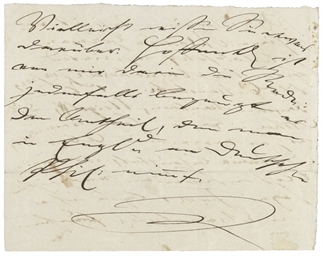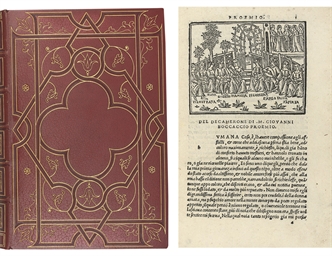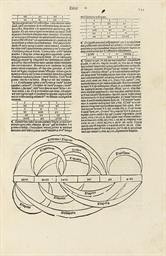LIGETI, György (1923-2006). Autograph music manuscript, 'Atmosphères für grosses Orchester ohne Schlagzeug Kompositionsauftrag des Südwestfunks, Baden-Baden 1961', with a note on the performance timing, giving a minimum total duration of 8'34", though 'The piece can be played more slowly (ideal total duration 9' - 9'30")', the calligraphic manuscript prepared for the press, in German, in pencil, title and 23 pages, double-folio (822 x 303mm) , the leaves formed from two attached folio leaves (some pin holes to margins), typescript performance instructions, particularly for the execution of the piano parts, which are to be played using jazz brushes by two performers standing either side of an open grand piano, on 1¼ leaves, folio , laid down on title, paper wrappers; together with the printed score by Universal Edition [1963], 2nd impression, including a reduced facsimile of the present manuscript, and another edition, in a blue cloth case.
LIGETI, György (1923-2006). Autograph music manuscript, 'Atmosphères für grosses Orchester ohne Schlagzeug Kompositionsauftrag des Südwestfunks, Baden-Baden 1961', with a note on the performance timing, giving a minimum total duration of 8'34", though 'The piece can be played more slowly (ideal total duration 9' - 9'30")', the calligraphic manuscript prepared for the press, in German, in pencil, title and 23 pages, double-folio (822 x 303mm) , the leaves formed from two attached folio leaves (some pin holes to margins), typescript performance instructions, particularly for the execution of the piano parts, which are to be played using jazz brushes by two performers standing either side of an open grand piano, on 1¼ leaves, folio , laid down on title, paper wrappers; together with the printed score by Universal Edition [1963], 2nd impression, including a reduced facsimile of the present manuscript, and another edition, in a blue cloth case. AN ICONIC WORK IN 20TH-CENTURY MUSIC. Atmosphères was a landmark work, introducing an utterly unfamiliar acoustic world: it begins with a monolithic cluster chord, pianissimo , in which each of 56 string players plays a different note, encompassing the whole chromatic scale over 5 octaves, and moves forward in a dream world, 'almost a single cloud, drifting through different regions of colour, harmony and texture, whether in the form of sustained tones (remarkably for the period, there is only one percussion instrument: a piano whose strings are brushed towards the close) or of what he called "micropolyphony", consisting of dense weaves of canons at the unison, in which the lines moved at different speeds and are not separately identifiable' (Grove). Ligeti's own commentary on the term 'micropolyphony' describes it as a 'harmonic-musical flow, in which the harmonies do not change suddenly, but merge into one another; one clearly discernible interval combination is gradually blurred, and from this cloudiness it is possible to discern a new interval combination taking shape'; and the performance note to Atmosphères re-inforces this emphasis on timelessness, noting that 'The bar lines are in this piece purely a means of synchronisation of the individual parts and an aid to temporal articulation. There is no such thing as a beat in the sense of metrical pulsation ... The piece should -- with the exception of a few specified places -- be played completely without accent'. The composition of Atmosphères emerged from a period of experimentation with electronic music (working alongside Karlheinz Stockhausen) and its concern with pure texture was to set the tone for Ligeti's concerns throughout the 1960s. It was first performed by the SWR Radio Symphony Orchestra directed by Hans Rosbaud on 22 October 1961. Atmosphères was accorded an ecstatic reception in its early performances, but the work and its composer came to broader fame through its initially unlicensed use (along with excerpts from the Ligeti's Lux Aeterna and Requiem ) in Stanley Kubrick's 2001: A Space Odyssey , where it is used to evoke the vastness and timelessness of deep space. The revolutionary nature of this piece and its popularisation by Kubrick elevated Ligeti, and Atmosphères in particular, to an iconic position in the public reception of the musical avant-garde.
LIGETI, György (1923-2006). Autograph music manuscript, 'Atmosphères für grosses Orchester ohne Schlagzeug Kompositionsauftrag des Südwestfunks, Baden-Baden 1961', with a note on the performance timing, giving a minimum total duration of 8'34", though 'The piece can be played more slowly (ideal total duration 9' - 9'30")', the calligraphic manuscript prepared for the press, in German, in pencil, title and 23 pages, double-folio (822 x 303mm) , the leaves formed from two attached folio leaves (some pin holes to margins), typescript performance instructions, particularly for the execution of the piano parts, which are to be played using jazz brushes by two performers standing either side of an open grand piano, on 1¼ leaves, folio , laid down on title, paper wrappers; together with the printed score by Universal Edition [1963], 2nd impression, including a reduced facsimile of the present manuscript, and another edition, in a blue cloth case.
LIGETI, György (1923-2006). Autograph music manuscript, 'Atmosphères für grosses Orchester ohne Schlagzeug Kompositionsauftrag des Südwestfunks, Baden-Baden 1961', with a note on the performance timing, giving a minimum total duration of 8'34", though 'The piece can be played more slowly (ideal total duration 9' - 9'30")', the calligraphic manuscript prepared for the press, in German, in pencil, title and 23 pages, double-folio (822 x 303mm) , the leaves formed from two attached folio leaves (some pin holes to margins), typescript performance instructions, particularly for the execution of the piano parts, which are to be played using jazz brushes by two performers standing either side of an open grand piano, on 1¼ leaves, folio , laid down on title, paper wrappers; together with the printed score by Universal Edition [1963], 2nd impression, including a reduced facsimile of the present manuscript, and another edition, in a blue cloth case. AN ICONIC WORK IN 20TH-CENTURY MUSIC. Atmosphères was a landmark work, introducing an utterly unfamiliar acoustic world: it begins with a monolithic cluster chord, pianissimo , in which each of 56 string players plays a different note, encompassing the whole chromatic scale over 5 octaves, and moves forward in a dream world, 'almost a single cloud, drifting through different regions of colour, harmony and texture, whether in the form of sustained tones (remarkably for the period, there is only one percussion instrument: a piano whose strings are brushed towards the close) or of what he called "micropolyphony", consisting of dense weaves of canons at the unison, in which the lines moved at different speeds and are not separately identifiable' (Grove). Ligeti's own commentary on the term 'micropolyphony' describes it as a 'harmonic-musical flow, in which the harmonies do not change suddenly, but merge into one another; one clearly discernible interval combination is gradually blurred, and from this cloudiness it is possible to discern a new interval combination taking shape'; and the performance note to Atmosphères re-inforces this emphasis on timelessness, noting that 'The bar lines are in this piece purely a means of synchronisation of the individual parts and an aid to temporal articulation. There is no such thing as a beat in the sense of metrical pulsation ... The piece should -- with the exception of a few specified places -- be played completely without accent'. The composition of Atmosphères emerged from a period of experimentation with electronic music (working alongside Karlheinz Stockhausen) and its concern with pure texture was to set the tone for Ligeti's concerns throughout the 1960s. It was first performed by the SWR Radio Symphony Orchestra directed by Hans Rosbaud on 22 October 1961. Atmosphères was accorded an ecstatic reception in its early performances, but the work and its composer came to broader fame through its initially unlicensed use (along with excerpts from the Ligeti's Lux Aeterna and Requiem ) in Stanley Kubrick's 2001: A Space Odyssey , where it is used to evoke the vastness and timelessness of deep space. The revolutionary nature of this piece and its popularisation by Kubrick elevated Ligeti, and Atmosphères in particular, to an iconic position in the public reception of the musical avant-garde.















Try LotSearch and its premium features for 7 days - without any costs!
Be notified automatically about new items in upcoming auctions.
Create an alert